|
项目 |
内容 |
|
这个作业属于哪个课程 |
https://www.cnblogs.com/nwnu-daizh/ |
|
这个作业的要求在哪里 |
https://www.cnblogs.com/nwnu-daizh/p/11435127.html |
|
作业学习目标 |
(1) 掌握Java应用程序的打包操作; (2) 掌握线程概念; (3) 掌握线程创建的两种技术。 (4) 学习设计应用程序的GUI。 |
实验十四 应用程序归档与线程初步
第一部分:理论知识总结
14.1 什么是线程
1、程序、进程与线程
程序是一段静态的代码,它是应用程序执行的蓝本。 进程是程序的一次动态执行,它对应了从代码加载、执行至执行完毕的一个完整过程。 线程是进程执行过程中产生的多条执行线索。 线程是比进程执行更小的单位。

2、Java中实现多线程应用有两种途径:
(1)创建Thread类的子类
用Thread类的子类创建线程
只需从Thread类派生出一个子类,在类中一定要实现run()。
例: class hand extends Thread
{
public void run()
{…….}
}
案例:
class Lefthand extends Thread {
public void run(){
for(int i=0;i<=5;i++)
{
System.out.println("You are Students!");
try{
sleep(500);
}
catch(InterruptedException e) {… }
}
}
}
(2)在程序中实现Runnable接口
用Runnable()接口实现多线程时,必须实现run()方法,也用start()启动线程。
用Runnable()接口实现多线程时,常用Thread类的构造方法来创建线程对象。
class BallRunnable implements Runnable
{
public void run(){
try {
for (int i = 1; i <= STEPS; i++) {
ball.move(component.getBounds());
component.repaint();
Thread.sleep(DELAY);
}
} catch (InterruptedException e){}
}
API:java.lang.Thread Thread(Runnable r) Runnable r = new BallRunnable(b, comp);
Thread t = new Thread(r);
创建一个新线程,它调用r的run(), r是一个实现了Runnable接口的类的实例。
14.2 中断线程
当线程的run方法执行方法体中最后一条语句后,并经由执行return语句返回时,或者出现了在方法中没有捕获的异常时,线程将终止。 在程序中常常调用interrupt()来终止线程,interrupt()不仅可中断正在运行的线程,而且也能中断处于blocked状态的线程,此时interrupt()会抛出一个InterruptedException异常。 Java提供了几个用于测试线程是否被中断的方法。
void interrupt()
向一个线程发送一个中断请求,同时把这个线程的“interrupted”状态置为true。 若该线程处于blocked状态,会抛出InterruptedException。
static boolean interrupted()
检测当前线程是否已被中断,并重置状态“interrupted”值为false。
boolean isInterrupted()
检测当前线程是否已被中断,不改变状态“interrupted”值 。
14.3 线程状态
1、线程一共有如下6种状态:
New (新建)
Runnable (可运行)
Blocked (被阻塞)
Waiting (等待)
Timed waiting (计时等待)
Terminated (被终止)
2、新创建线程
new(新建) 线程对象刚刚创建,还没有启动,此时还处于不可运行状态。
Thread thread=new Thread(“test”) 此时线程thread处于新建状态,但已有了相应的内存空间以及其它资源。
3、可运行线程
runnable(可运行状态) 此时的线程已经启动,处于线程的run()方法之中。 此时的线程可能运行,也可能不运行,只要CPU一空闲,马上就会运行。 调用线程的start()方法可使线程处于“可运行”状态。
thread.start()
blocked (被阻塞) 一个正在执行的线程因特殊原因,被暂停执行,进入阻塞状态。 阻塞时线程不能进入队列排队,必须等到引起阻塞的原因消除,
才可重新进入排队队列。 引起阻塞的原因很多,不同原因要用不同的方法解除。
sleep(),wait()是两个常用引起阻塞的方法。
Terminated (被终止) 线程被终止的原因有二: 一是run()方法中最后一个语句执行完毕,因而自然死亡。 二是因为一个没有捕获的异常终止了run
方法,从而意外死亡。 thread.stop() 可以调用线程的stop方法杀死一个线程,但是,stop方法已过时,不要在自己的代码中调用它。
4、线程的挂起和恢复
suspend() 和 resume() 方法:两个方法配套使用,suspend()使得线程进入阻塞状态,并且不会自动恢复,必须其对应的 resume() 被调用,才能
使得线程重新进入可执行状态。 suspend() 和 resume() 被用在等待另一个线程产生的结果的情形:测试发现结果还没有产生后,让线程阻塞,另
一个线程产生了结果后,调用 resume() 使其恢复。但suspend()方法很容易引起死锁问题,已经不推荐使用了。
第二部分:实验内容和步骤
实验1: 导入第13章示例程序,测试程序并进行代码注释。
测试程序1
l 在elipse IDE中调试运行教材585页程序13-1,结合程序运行结果理解程序;
l 将所生成的JAR文件移到另外一个不同的目录中,再运行该归档文件,以便确认程序是从JAR文件中,而不是从当前目录中读取的资源。
l 掌握创建JAR文件的方法;
实验代码:
package 线程; import java.awt.*; import java.io.*; import java.net.*; import java.util.*; import javax.swing.*; /** * @version 1.41 2015-06-12 * @author Cay Horstmann */ public class ResourceTest { public static void main(String[] args) { //设置图像界面窗口 EventQueue.invokeLater(() -> { JFrame frame = new ResourceTestFrame(); frame.setTitle("ResourceTest"); frame.setDefaultCloseOperation(JFrame.EXIT_ON_CLOSE); frame.setVisible(true); }); } } /** * A frame that loads image and text resources. */ class ResourceTestFrame extends JFrame { private static final int DEFAULT_WIDTH = 300; private static final int DEFAULT_HEIGHT = 300; public ResourceTestFrame() { setSize(DEFAULT_WIDTH, DEFAULT_HEIGHT);//设置框架大小 URL aboutURL = getClass().getResource("about.gif"); //利用about.gif图像文件制作图标 Image img = new ImageIcon(aboutURL).getImage(); setIconImage(img); JTextArea textArea = new JTextArea();//创建一个文本空白框 InputStream stream = getClass().getResourceAsStream("about.txt");//读取about.txt文件 try (Scanner in = new Scanner(stream, "UTF-8")) { while (in.hasNext())//判断读取文件的该行是否有数据 textArea.append(in.nextLine() + " "); } add(textArea);//将读取的文件添加到文本域中 } }
实验结果:
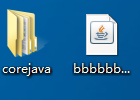
点击后:

测试程序2:
l 在elipse IDE中调试运行ThreadTest,结合程序运行结果理解程序;
l 掌握线程概念;
l 掌握用Thread的扩展类实现线程的方法;
利用Runnable接口改造程序,掌握用Runnable接口创建线程的方法。
class Lefthand extends Thread { public void run() { for(int i=0;i<=5;i++) { System.out.println("You are Students!"); try{ sleep(500); } catch(InterruptedException e) { System.out.println("Lefthand error.");} } } } class Righthand extends Thread { public void run() { for(int i=0;i<=5;i++) { System.out.println("I am a Teacher!"); try{ sleep(300); } catch(InterruptedException e) { System.out.println("Righthand error.");} } } } public class ThreadTest { static Lefthand left; static Righthand right; public static void main(String[] args) { left=new Lefthand(); right=new Righthand(); left.start(); right.start(); } }
利用Runnable接口改造程序后
package 线程; //线程的接口Runnable class Lefthand implements Runnable{ @Override public void run() { for(int i=0;i<=5;i++) { System.out.println("You are Students!"); try{ Thread.sleep(500); } catch(InterruptedException e) { System.out.println("Lefthand error.");} } } } class Righthand implements Runnable { public void run() { for(int i=0;i<=5;i++) { System.out.println("I am a Teacher!"); try{ Thread.sleep(300); } catch(InterruptedException e) { System.out.println("Righthand error.");} } } } public class ThreadTest { static Lefthand left; static Righthand right; public static void main(String[] args) { left=new Lefthand(); right=new Righthand(); new Thread(left).start(); new Thread(right).start(); } }
运行结果:
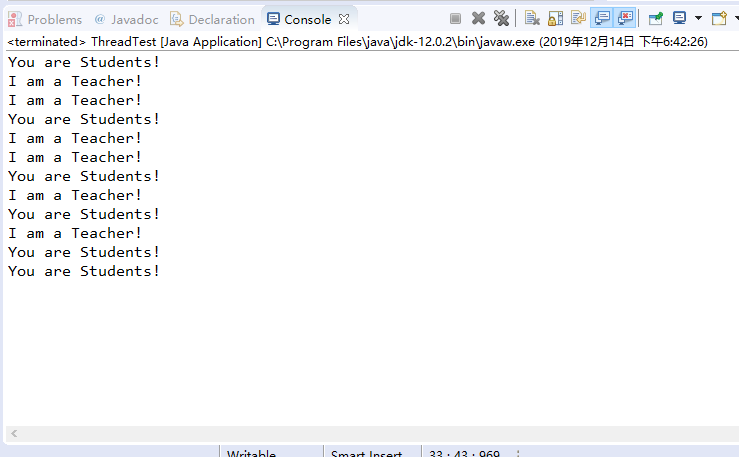
测试程序3:
l 在Elipse环境下调试教材625页程序14-1、14-2 、14-3,结合程序运行结果理解程序;
l 在Elipse环境下调试教材631页程序14-4,结合程序运行结果理解程序;
l 对比两个程序,理解线程的概念和用途;
l 掌握线程创建的两种技术。
14-1
package 线程; import java.awt.*; import java.awt.event.*; import javax.swing.*; /** * Shows an animated bouncing ball. * @version 1.34 2015-06-21 * @author Cay Horstmann */ public class Bounce { public static void main(String[] args) { EventQueue.invokeLater(() -> { JFrame frame = new BounceFrame(); frame.setDefaultCloseOperation(JFrame.EXIT_ON_CLOSE); frame.setVisible(true); });//创建一个GUI界面 } } /** * The frame with ball component and buttons. */ class BounceFrame extends JFrame { private BallComponent comp; public static final int STEPS = 1000; public static final int DELAY = 3; /*构造包含用于显示弹跳球和启动和关闭按钮*/ public BounceFrame() { setTitle("Bounce"); comp = new BallComponent(); add(comp, BorderLayout.CENTER);//设置组件在页面的布局为边框布局的中央 JPanel buttonPanel = new JPanel(); addButton(buttonPanel, "Start", event -> addBall());//添加按钮到按钮面板中,并为其添加事件监听器addBall方法 addButton(buttonPanel, "Close", event -> System.exit(0)); add(buttonPanel, BorderLayout.SOUTH);// pack(); } /** * Adds a button to a container. * @param c the container * @param title the button title * @param listener the action listener for the button */ public void addButton(Container c, String title, ActionListener listener) { JButton button = new JButton(title); c.add(button); button.addActionListener(listener); } /* 在面板中添加一个弹跳球,使其弹跳1000次。 */ public void addBall() { try { Ball ball = new Ball(); comp.add(ball); for (int i = 1; i <= STEPS; i++) { ball.move(comp.getBounds()); comp.paint(comp.getGraphics()); Thread.sleep(DELAY);//调用线程当中的Thread.sleep方法。用于暂停当前的线程活动 } } catch (InterruptedException e) { } } }
14-2
package 线程; import java.awt.geom.*; /* 在长方形边缘上移动和反弹的球*/ public class Ball { private static final int XSIZE = 15; private static final int YSIZE = 15; private double x = 0; private double y = 0; private double dx = 1; private double dy = 1; // 将球移动到下一个位置,如果球碰到其中一个边,则反转方向 public void move(Rectangle2D bounds) { x += dx; y += dy; if (x < bounds.getMinX()) { x = bounds.getMinX(); dx = -dx; } if (x + XSIZE >= bounds.getMaxX()) { x = bounds.getMaxX() - XSIZE; dx = -dx; } if (y < bounds.getMinY()) { y = bounds.getMinY(); dy = -dy; } if (y + YSIZE >= bounds.getMaxY()) { y = bounds.getMaxY() - YSIZE; dy = -dy; } } //获取球在其当前位置的形状 public Ellipse2D getShape() { return new Ellipse2D.Double(x, y, XSIZE, YSIZE); } }
14-3
package 线程; import java.awt.*; import java.util.*; import javax.swing.*; public class BallComponent extends JPanel { private static final int DEFAULT_WIDTH = 450; private static final int DEFAULT_HEIGHT = 350; private java.util.List<Ball> balls = new ArrayList<>(); //在面板上添加一个球 public void add(Ball b) { balls.add(b); } public void paintComponent(Graphics g) { super.paintComponent(g); // erase background Graphics2D g2 = (Graphics2D) g; for (Ball b : balls) { g2.fill(b.getShape()); } } public Dimension getPreferredSize() { return new Dimension(DEFAULT_WIDTH, DEFAULT_HEIGHT); } }
运行结果:
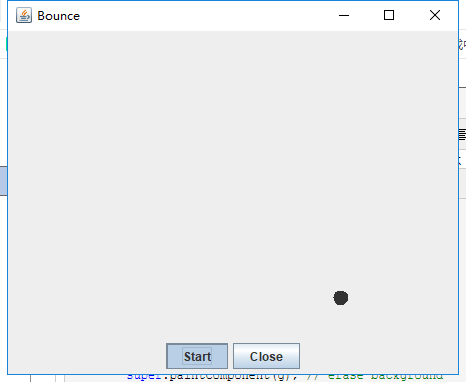
14-4
package Main; import java.awt.*; import java.awt.event.*; import javax.swing.*; /** * Shows animated bouncing balls. * @version 1.34 2015-06-21 * @author Cay Horstmann */ public class BounceThread { public static void main(String[] args) { EventQueue.invokeLater(() -> { JFrame frame = new BounceFrame(); frame.setTitle("BounceThread"); frame.setDefaultCloseOperation(JFrame.EXIT_ON_CLOSE); frame.setVisible(true); }); } } //在框架上添加面板和按钮 class BounceFrame extends JFrame { private BallComponent comp; public static final int STEPS = 1000; public static final int DELAY = 5; //构造包含用于显示弹跳球和启动和关闭按钮 public BounceFrame() { comp = new BallComponent(); add(comp, BorderLayout.CENTER); JPanel buttonPanel = new JPanel(); addButton(buttonPanel, "Start", event -> addBall()); addButton(buttonPanel, "Close", event -> System.exit(0)); add(buttonPanel, BorderLayout.SOUTH); pack(); } public void addButton(Container c, String title, ActionListener listener) { JButton button = new JButton(title); c.add(button); button.addActionListener(listener); } // 在画布上添加一个弹跳球并开始一条线使其弹跳 public void addBall() { Ball ball = new Ball(); comp.add(ball); Runnable r = () -> { try { for (int i = 1; i <= STEPS; i++) { ball.move(comp.getBounds()); comp.repaint(); Thread.sleep(DELAY); } } catch (InterruptedException e) { } }; Thread t = new Thread(r); t.start(); } }
运行结果:

第三部分:结对编程练习
采用GUI界面设计以下程序,并创建程序归档文件。
设计一个100以内整数小学生四则运算练习程序,由计算机随机产生10道加减乘除练习题,学生输入答案,由程序检查答案是否正确,每道题正确计10分,错误不计分,10道题测试结束后给出测试总分;
将程序中测试练习题及学生答题结果输出到文件,文件名为test.txt。
代码如下:
package jsq; import java.awt.EventQueue; import javax.swing.JFrame; public class jsq { public static void main(String[] args) { EventQueue.invokeLater(()->{ JFrame g = new gui(); g.setVisible(true); g.setDefaultCloseOperation(JFrame.EXIT_ON_CLOSE); new jisuan(); }); } }
package jsq; import java.io.*; import java.math.*; import javax.swing.JTextArea; public class jisuan { char fh; public int m() { int m = (int)(1+Math.random()*100); return m; } public int n() { int n = (int)(1+Math.random()*100); return n; } public char fh() { int x = (int)(1+Math.random()*4); switch (x) { case 1: fh='+'; break; case 2: fh='-'; break; case 3: fh='*'; break; case 4: fh='/'; break; } return fh; } public int pd(int m, char fh ,int n) { int jg=0 ; switch (fh) { case '+': jg = m+n; break; case '-': jg = m-n; break; case '*': jg = m*n; break; case '/': jg = m/n; break; } return jg; } public void wfile(String str) { File f = new File("C:\Users\huhuanhuan\Desktop\test.txt"); try { BufferedWriter b = new BufferedWriter(new FileWriter("C:\Users\huhuanhuan\Desktop\test.txt")); b.write(str); b.close(); } catch (IOException e) { // TODO Auto-generated catch block e.printStackTrace(); } } }
package jsq; import java.awt.*; import java.awt.event.ActionEvent; import java.awt.event.ActionListener; import javax.swing.*; public class gui extends JFrame { int m,n,jg,cj,jsq,btcj,sj,sjjg=1; char fh; public static int width=600; public static int height=400; JPanel JP0 = new JPanel(); JPanel JP1 = new JPanel(); JPanel JP2 = new JPanel(); JLabel L1 = new JLabel(); JLabel L2 = new JLabel(); JLabel L3 = new JLabel(); JLabel L4 = new JLabel(); JLabel L5 = new JLabel(); JLabel L6 = new JLabel(); JTextField text = new JTextField(); JTextField text1 = new JTextField(); JTextArea Are = new JTextArea(); JButton ks = new JButton("开始答题"); JButton xyt = new JButton("下一题"); JButton jc = new JButton("检查"); JButton jj = new JButton("交卷"); jisuan j = new jisuan(); JOptionPane o; ActionListener listener1 = new time(); Timer t = new Timer(1000,listener1); public gui() { Dimension scrSize=Toolkit.getDefaultToolkit().getScreenSize(); setBounds((scrSize.width-width)/2,(scrSize.height-height)/2,width,height); JP1.setBounds(0,0,width,height/2); JP2.setBounds(0,200,width,height/2); JP0.setBounds(0, 0, width, height); add(JP1); add(JP2); JP1.setLayout(null); JP2.setLayout(null); L1.setBounds(150, 40, width/10, height/8); L1.setText("题目:"); JP1.add(L1); L2.setBounds(150, 83, width/10, height/8); L2.setText("答案:"); JP1.add(L2); L3.setBounds(210, 40, width/6, height/8); JP1.add(L3); L4.setBounds(310, 40, width/6, height/8); JP1.add(L4); L5.setBounds(230, 10, 220, height/12); L5.setVisible(false); Font font = new Font("Default",Font.PLAIN,30); L5.setFont(font); L5.setForeground(Color.red); JP1.add(L5); L6.setBounds(103, 10, 90, height/12); L6.setText("输入倒计时/s:"); JP1.add(L6); text.setBounds(190, 95, 220, height/12); JP1.add(text); text1.setBounds(190, 10, 220, height/12); JP1.add(text1); ks.setBounds(240, 200, 120, 45); JP2.add(ks); jc.setBounds(170, 200, 120, 45); xyt.setBounds(310, 200, 120, 45); jj.setBounds(310, 200, 120, 45); jc.setVisible(false); xyt.setVisible(false); jj.setVisible(false); JP2.add(jc); JP2.add(xyt); JP2.add(jj); ks.addActionListener(event->{ ks.setVisible(false); jc.setVisible(true); xyt.setVisible(true); // var j = new jisuan(); m = j.m(); n = j.n(); fh = j.fh(); L3.setText(m+" "+fh+" "+n+" "+"="); L6.setVisible(false); text1.setVisible(false); L5.setVisible(true); sj=Integer.parseInt(text1.getText()); t.start(); }); xyt.addActionListener(event->{ jsq++; Are.append(m+" "+fh+" "+n+" "+"="+" "+jg+" 本题得分:"+btcj+' '); m = j.m(); n = j.n(); fh = j.fh(); L3.setText(m+" "+fh+" "+n+" "+"="); text.setText(""); L4.setText(""); btcj=0; jg=0; if(jsq==9) { xyt.setVisible(false); jj.setVisible(true); } }); jc.addActionListener(event->{ jg = (Integer.parseInt(text.getText())); if((j.pd(m, fh, n))==(jg)) { L4.setText(jg+" "+"√"); L4.setForeground(Color.green); btcj=10; } else { L4.setText(jg+" "+"×"); L4.setForeground(Color.red); btcj=0; } cj=cj+btcj; }); jj.addActionListener(event->{ JP1.setVisible(false); JP2.setVisible(false); Are.setSize(width, height); add(Are); Are.append(m+" "+fh+" "+n+" "+"="+" "+jg+" 本题得分:"+btcj+' '); Are.append("总分:"+cj); j.wfile(Are.getText()); }); } class time implements ActionListener{ @Override public void actionPerformed(ActionEvent e) { // TODO Auto-generated method stub if(sj==0) { o.showMessageDialog(gui.this, "时间到");; t.stop(); text.setEditable(false); } L5.setText(" "+sj); sj--; Toolkit.getDefaultToolkit().beep(); } } }
运行界面及导出的jar文件如下:
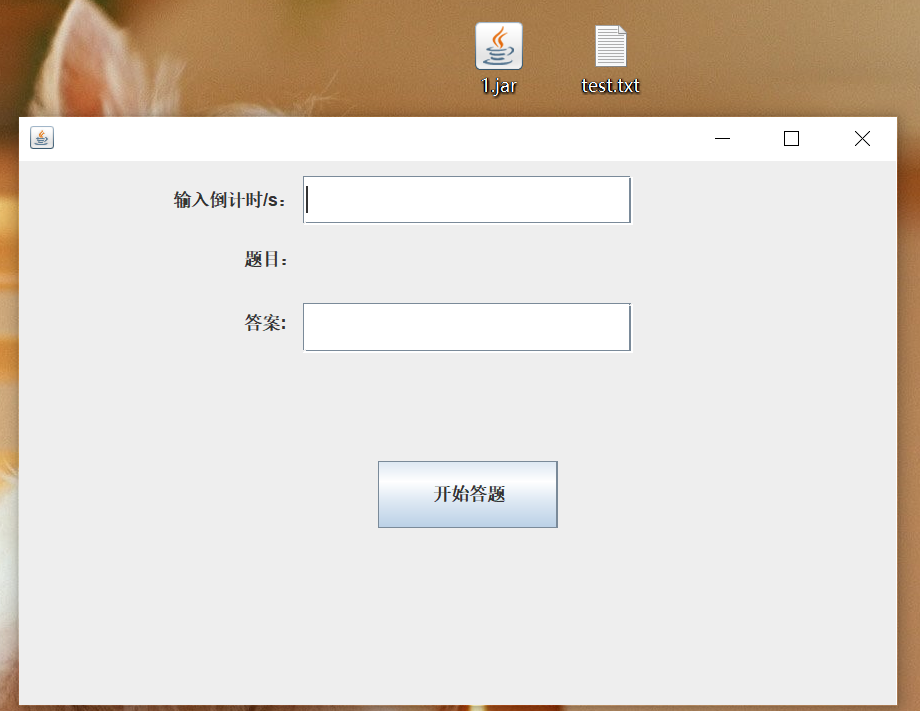
运行时截图:

倒计时结束弹出提示并设置文本框为禁止输入:


运行完截图及输出test.txt文件截图:


结对编程照片:
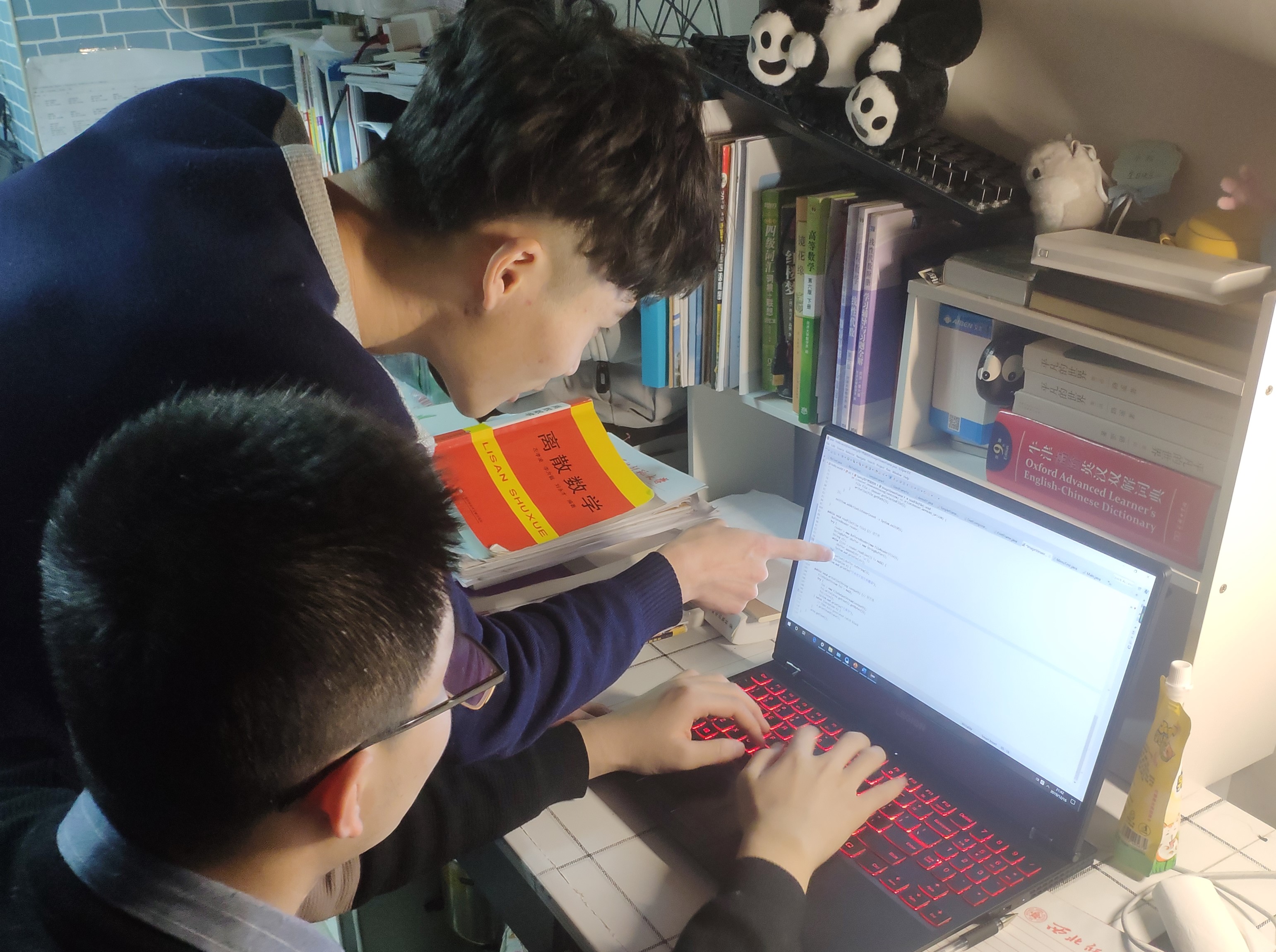
第四部分:实验总结
通过本次实验,我初步理解了程序、进程和线程的概念,以及创建线程和中断线程的方法,还有线程的几种状态,并且完成了结对编程练习,此次结对编程练习对我的帮助很大,在结对编程中我复习了很多前面的知识,对lambda表达式,事件处理,布局管理器等的运用更加得心应手,编程能力有所提高,我会继续努力。